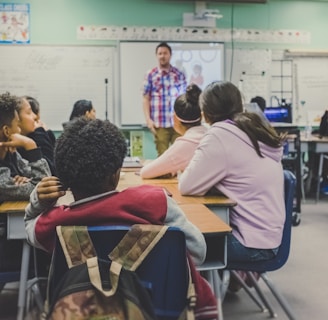From Honeymoon to Full Moon: How to Talk to Students So They Listen (and Behave)
The first week of class is calm—the “honeymoon phase.” But when that ends and disruptive behaviors emerge, connection—not just consequences—makes all the difference. Learn how to talk to students in a way that earns their trust, encourages respect, and helps maintain a positive classroom environment. This is the first of a multi-installment series on classroom management.
LEADERSHIPTEACHING
Jon Tomski
2/2/20252 min read


It's the first week of class, and so far, it's been "all quiet on the western front"—the students are still in that blissful honeymoon phase, not yet "communicating" with you through their, shall we say, expressive behaviors. Then, BAM! That first full moon hits, and your "frequent flyers" from the main office suddenly materialize. The natural reaction? To lament the impending doom of your school year and dust off the same old bag of tricks, putting the office on red alert.
But it doesn't have to be that way.
Relationships are the magic key to unlocking about 95% of classroom behavior issues. I say 95% because there's always that elusive 5%—the kids who just...don't do school. And if I knew all the reasons why and how to address them, I'd probably be sipping mai tais on a beach in Maui right now. But for the other 95%, I firmly believe that taking the time to build a relationship, through genuine conversation, can lead them to classroom success, or at the very least, prevent them from disrupting your instruction (and everyone else's learning).
So, when that honeymoon ends and the first full moon rises, ask that student to stay after class. Chances are, this isn't their first rodeo. They know the drill, they know what they've done. But instead of the usual reprimand or a rehash of classroom rules, just…talk to them. Get to know them. Ask about their interests, their evening plans, what they do for fun. Basically, make a deposit in their emotional bank account with genuine interest and caring—and don't even mention what happened in class. Then, use what you learn in future interactions, whether it's a quick chat in the hallway, cafeteria, playground, or one of those slightly awkward run-ins at the grocery store or local park. Show them you value them. If you show genuine interest and care, the vast majority will return the favor.
Students, especially our more challenging students, have a finely tuned authenticity detector. If you can genuinely show them that you value and care for them as an individual, you'll have made a hefty deposit in that emotional bank account, and they, in turn, will value you as a person and their teacher. It might be the first time a teacher has spoken to them that way, genuinely cared. It's entirely possible that this one conversation will stick with them for life. You just created a memory with a potentially huge impact.
Will a simple, authentic conversation solve every behavior problem? Nope. But I believe it can work for most. But what happens when you've built a relationship, and the behaviors continue? Ah, that brings us to our next installment: communication. Stay tuned!
